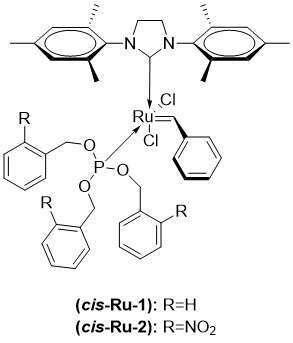
Latent ruthenium benzylidene phosphite complexes for visible light induced olefin metathesis
The use of light to initiate a latent metathesis catalyst carries a great potential for industrial applications. Recently, the photoactivation of latent ruthenium phosphite complexes for olefin metathesis was reported by our group.1 Thus, commercially available ruthenium indenyledene complex cis-Caz-1 was studied for various olefin metathesis reactions showing excellent activity when irradiated with UV-A light at ambient temperature. When Cazin and co-workers studied ruthenium benzylidene complexes bearing phosphite ligands, the resulting complexes adopted a trans-dichloro configuration and were not latent towards olefin metathesis.2 To circumvent the latency problem of benzylidene phosphite complexes, we designed cis-PhosRu-1, a chelated benzylidene phosphite complex. The chelation effect imposed a cis-dichloro configuration, and the complex was latent under ambient conditions and could be photoactivated with 405 nm light. Unfortunately, the catalytic activity of this complex was inferior to that of cis-Caz-1. Here, we report two new ruthenium benzylidene complexes with benzylphosphite ligands. Unlike the previously reported benzylidene phosphite complexes, these benzylphosphite complexes adopt a cis-dichloro configuration making them latent at ambient temperatures. Irradiation with visible light (420 nm and blue LED) prompts activation of the complexes and induces catalysis of olefin metathesis reactions. One of the complexes, cis-Ru-1, was found especially suitable for 3D printing of multilayered polydicyclopentadiene structures with excellent spatial resolutions. Additionally, complex cis-Ru-2 was designed with a chromatic orthogonal `kill switch` based on the 2-nitrobenzyl chemistry, allowing the destruction of the catalyst upon exposure to UV-C light.

[1] Eivgi, O.; Guidone, S.; Frenklah, A.; Kozuch, S.; Goldberg, I.; Lemcoff, N. G. ACS Catal. 2018, 8, 6413-6418
[2] Schmid, T. E.; Bantreil, X.; Citadelle, C. A.; Slawin, A. M. Z.; Cazin, C. S. J., Chem. Commun. 2011, 47, 7060-7062
Powered by Eventact EMS